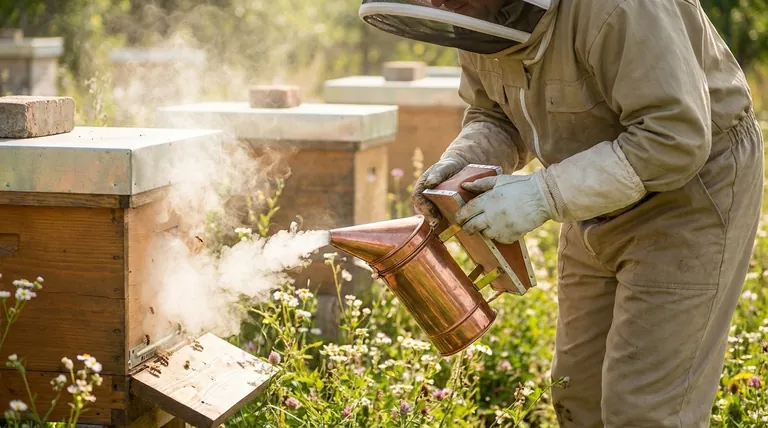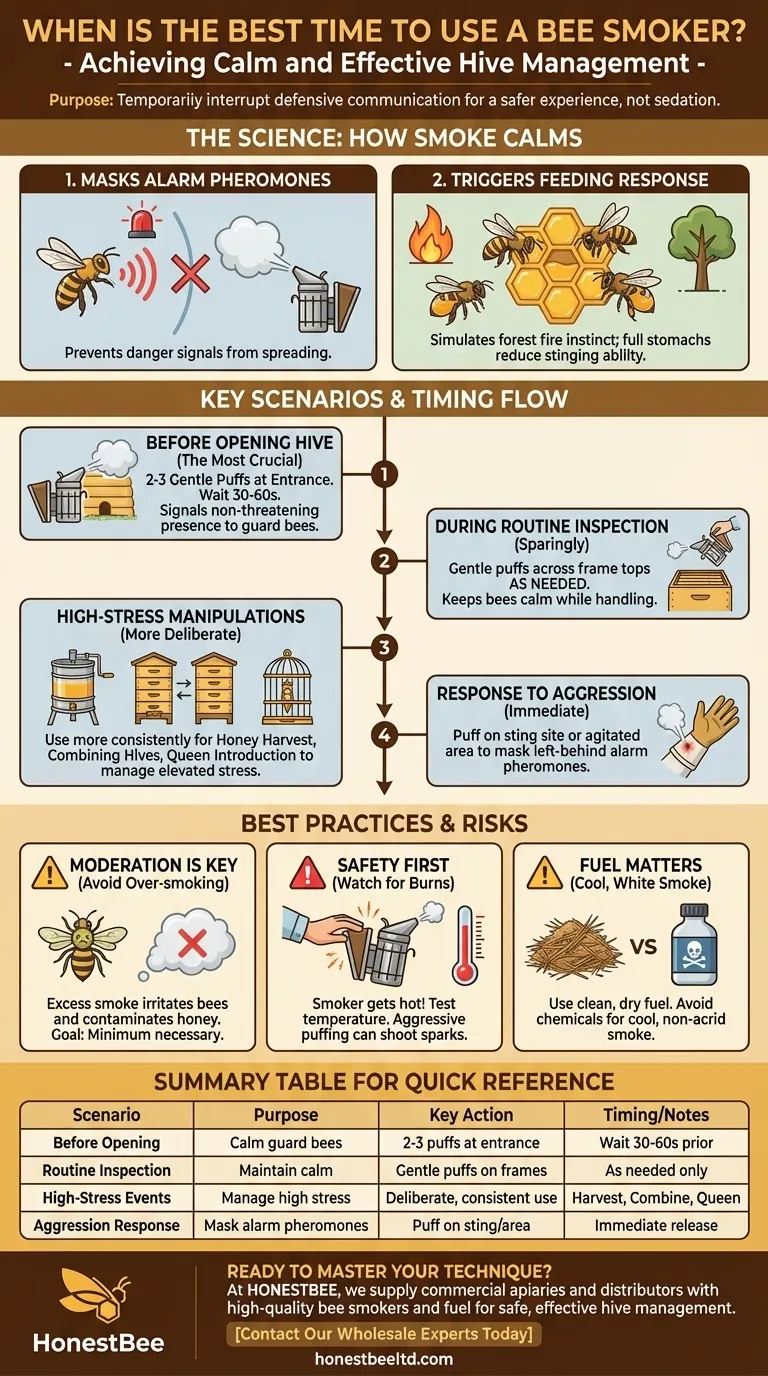The best time to use a bee smoker is immediately before you open a hive and, sparingly, during the inspection itself. Applying a few gentle puffs of smoke at the hive entrance 30-60 seconds before entry gives the bees time to respond, making for a much calmer inspection.
The purpose of a bee smoker is not to sedate or harm the bees, but to temporarily interrupt their defensive communication. Correctly used, it is a tool for preventing alarm, ensuring a safer and less stressful experience for both the colony and the beekeeper.

How Smoke Calms a Beehive
To use a smoker effectively, you must first understand why it works. The smoke triggers two key responses in honeybees.
It Masks Alarm Pheromones
When a honeybee feels threatened, it releases an alarm pheromone that signals danger to the rest of the colony, inciting a defensive response. The thick smoke from a smoker masks the scent of this pheromone, preventing the alarm from spreading throughout the hive.
It Triggers a Feeding Response
The presence of smoke also initiates a primal instinct in the bees related to a forest fire. They begin to gorge themselves on honey in preparation to potentially abandon the hive. Bees with full stomachs are physically less able to flex their abdomens to sting and are generally more docile.
Key Scenarios for Using a Smoker
While the primary use is for standard inspections, a smoker is critical during several specific and potentially disruptive situations.
Before Every Hive Opening
This is the most crucial time to use a smoker. Puffing a small amount of smoke into the hive entrance signals your presence in a non-threatening way and pre-emptively calms the guard bees.
During Routine Inspections
After opening the hive, you may need a few additional puffs across the tops of the frames to keep the bees calm as you work. This should be done as needed, not constantly.
For High-Stress Manipulations
Activities like honey extraction, combining two hives, or introducing a new queen are highly disruptive. Using smoke more deliberately during these events is necessary to manage the colony's heightened stress levels.
In Response to Aggression
If bees become agitated or "bumpy" during an inspection, a few gentle puffs of smoke can settle them down. If you are stung, smoking the area of the sting on your suit or skin can help mask the alarm pheromone left behind.
Understanding the Trade-offs and Risks
A smoker is a powerful tool, but improper use can be detrimental. True expertise lies in moderation and understanding the potential downsides.
The Danger of Over-smoking
Excessive smoke is harmful. It can irritate the bees, contaminate honey with a smoky flavor, and is unhealthy for the beekeeper to inhale. The goal is to use the minimum amount of smoke necessary to keep the bees calm.
The Risk of Burns
The smoker itself becomes extremely hot and must be handled with care. Furthermore, puffing the bellows too aggressively can shoot sparks or hot smoke into the hive, which can burn the bees' delicate wings. Always test the smoke temperature on the back of your hand from a safe distance.
The Importance of Good Fuel
Using clean, dry fuel is essential for producing cool, white smoke. Suitable fuels include dry pine needles, wood shavings, burlap, or commercial smoker fuels. Avoid materials treated with chemicals or anything that produces acrid, hot smoke.
Making the Right Choice for Your Goal
Your approach to using a smoker should adapt to the specific task and the temperament of your colony.
- If your primary focus is a routine inspection: Start with a few puffs at the entrance and use smoke sparingly only if the bees become agitated.
- If your primary focus is honey harvesting or combining hives: Be prepared to use smoke more consistently to manage the higher stress levels during these disruptive events.
- If your primary focus is managing an aggressive colony: Use calm, deliberate puffs of smoke as needed to maintain control, and smoke the area if you are stung to mask the alarm pheromones.
Mastering the bee smoker is a fundamental step toward becoming a calm, confident, and effective beekeeper.
Summary Table:
| Scenario | Purpose of Smoke | Key Action |
|---|---|---|
| Before Opening Hive | Pre-emptively calm guard bees | 2-3 puffs at entrance 30-60 sec prior |
| During Routine Inspection | Maintain calm while handling frames | Gentle puffs across frame tops as needed |
| High-Stress Manipulations | Manage heightened colony stress | More deliberate, consistent use |
| In Response to Aggression | Mask alarm pheromones, settle bees | Puff on sting site or agitated area |
Ready to master your beekeeping technique with the right equipment?
At HONESTBEE, we supply commercial apiaries and beekeeping equipment distributors with high-quality, reliable bee smokers and fuel. Using the right tools is essential for safe and effective hive management.
Contact our wholesale experts today to discuss your apiary's needs and discover how our equipment can help you work with confidence and care.
Visual Guide

Related Products
- Premium Traditional Copper Bee Smoker with Bellows
- Stainless Steel Honey Bee Smoker Hive and Honeycomb Smoker for Beekeeping
- Stainless Steel Electric Beehive Smoker for Beekeeping and Bee Keeper Use
- European Stainless Steel Bee Smoker for Honey Bee Hive
- Economy Galvanized Beekeeping Honey Bee Smoker for Wholesale
People Also Ask
- What happens to bees when they sense smoke? Unlock the Secret to Calm Hive Inspections
- What are the main components of a bee smoker? A Guide to Safe and Effective Hive Management
- How did early beekeepers use bee smokers? Master Ancient Bee Calming Techniques
- What is a Smoker and how is it used in beekeeping? The Essential Tool for Calm, Safe Hive Inspections
- How does water mist work as an alternative to smoke in beehives? A Guide to Safe & Effective Use



















